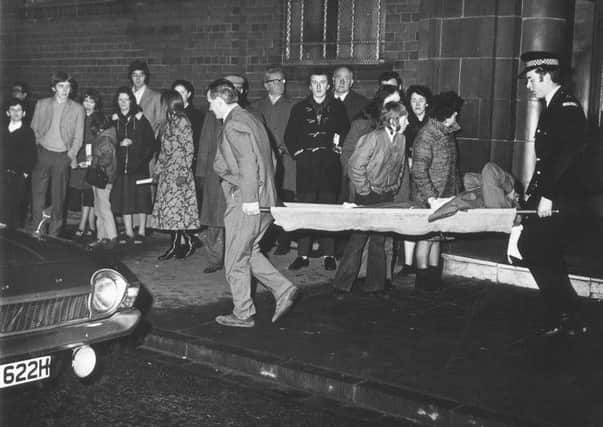40 years on, Ibrox disaster still haunts referee


Just over nine years later it became a car crash that scarred Bill and Margaret, his wife, forever.
Now it is dementia as the Andersons spend their days in a private nursing home in Melbourne, Australia.
Advertisement
Hide AdAdvertisement
Hide AdMore than four decades have passed since the Ibrox disaster, but the aftermath remains etched in the mind of the referee from East Kilbride.
He walked on to the pitch that dank and dreary day to a roar of about 80,000 fans who were there to watch Willie Waddell’s Rangers meet the challenge of Stein’s all-conquering Celtic. Anderson wasn’t fazed by the frenetic atmosphere. He was a tall, athletic man, a no-nonsense former centre half who, aged 39, was at the peak of his powers.
His stewardship of the 1968 Scottish Cup final between Dunfermline and Hearts was already a career highlight but now a Glasgow derby was to be added to his list of personal triumphs.
“It was a good game and there was nothing in it really, but a Jimmy Johnstone header put Celtic in front late on. But within a minute or so Colin Stein had levelled in injury time,” said Anderson. “We restarted for a wee while then I said ‘this’ll do me’ and I blew for time.”
Anderson and his linesmen had walked off the pitch unaware of what was taking place at stairway 13 on the east terrace, where a stumble had triggered a mass crush that became Scotland’s worst sporting disaster.
“The first I knew about anything going wrong was in our rooms when they came in and asked me if I knew first aid.
“I said ‘Why? Has someone collapsed?’ and they said ‘No, there’s some kids out here that might be dead.’
“I rushed out and they took me into this room and to this day I wished I’d never gone in there.
Advertisement
Hide AdAdvertisement
Hide Ad“See, when I saw these kids with broken arms, broken legs … holes in their bellies … they’d been crushed … I just felt sick, really sick.
“I thought I could have helped but I couldn’t help. They were gone. They were all dead … there was nothing that could be done for them.
“Later that night that’s when it started. The press started ringing me to find out what was going on and why so many people had died. I couldn’t answer those questions but this went on for days. If it wasn’t the Glasgow press it was the press from up north. They’d even ring through the night. I thought they’d never go away.”
They eventually did and, on 27 January, 1971, Anderson refereed a disaster benefit match between a Scotland select and a combined Rangers and Celtic side which drew a crowd of 81,000 to Hampden.
It was counselling of sorts – or the closest thing to it he would receive.
Although he refereed “for another five or six years”, Anderson was never the same. “I think I aged just going into that terrible room. After that it felt like I was just going through the motions as a referee.”
When he stopped refereeing he remained in football for two more years as a scout for Dundee United.
Originally from Strathaven in south Lanarkshire, Anderson had moved a few miles up the road years earlier and settled in East Kilbride, where Margaret gave birth to their son, Craig.
Advertisement
Hide AdAdvertisement
Hide AdEventually, his official ties with football were severed and he concentrated on his job as a cutting tool consultant with Sandvik, where Margaret worked in administration.
The Andersons were comfortable financially, happy enough in their three-bedroom semi-detached home.
They had relatives and friends in Adelaide, and Craig, then 20, kept talking about going to see his cousin in the South Australia state capital.
The Andersons paid their son’s air fare and, in October 1980, he flew to Australia for a holiday. Four days later there was a knock on the door at Loch Torridon, East Kilbride.
“It was the police and I wondered what was going on. They came into the lounge and told us that Craig had been killed in a car accident in Adelaide. Well, Margaret just collapsed.
“We wanted to take him back home initially, but then we decided that that wouldn’t be right. He’d wanted so much to go over there and see his cousin and our friends, so we held the funeral in Adelaide.
“His cousin was driving when the accident happened. Craig was the only one killed when a bus hit his side of the car. He didn’t have a chance.”
Almost two years later, the Andersons decided to move to Australia permanently and Sandvik arranged a job transfer for Bill. They spent a few weeks in Adelaide before settling in Melbourne, Victoria, where Bill worked until his retirement at age 65.
Advertisement
Hide AdAdvertisement
Hide AdHe turns 84 in June, which is testament to his resilience, and his love of football has never diminished despite the rigours to which it has subjected him.
“I got tremendous satisfaction out of refereeing but not out of being a referee because that meant people were always shouting at you.
“But if a game was going off well it was a great feeling, it really was. I still follow football back home. I’m a Hamilton Accies man myself.”
He speaks of the “very positive” effect of the Old Firm on the Scottish game, reasoning that both Celtic and Rangers continue to give young players something to aspire to. But surely it has taken more than football to cope with the trauma he has been forced to endure.
“Aye, there is something else,” he says with a nod toward his wheelchair-bound wife.
Margaret looks at him with a smile that almost dwarfs her diminutive frame.
He counts himself lucky that she has been smiling in his direction for more than 60 years.